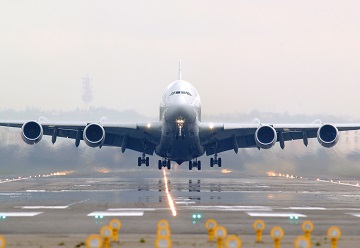
As a large and growing industry currently dependent on fossil fuels, aviation is clearly at the forefront of efforts to reduce and reverse environmental impacts from industrial processes. Our challenge, as passenger demand continues to grow, is to ensure the environmentally sustainable growth of global aerospace.
Emissions
Carbon emissions are the most obvious environmental impact of aircraft. Commercial aviation emits some 2% of global man-made CO2 emissions every year. Market pressure has ensured increased technological developments in fuel efficiency, with engines are being designed that are lighter, quieter and use fuel more efficiently. Today’s aircraft use at least 15% less fuel per passenger mile than those designed twenty years ago – and 80% less than the first generation of commercial jet airlines in the 1950s.
Noise
What do most people associate with flight? The answer is probably noise. This is a large part of opposition to airport expansion, yet individually commercial aircraft are quieter than they have ever been. Technology and airspace changes mean aircraft sound levels are more than 30 decibels less than 50 years ago – there are just many more of them in the skies! Regulators are requiring significantly quieter aircraft, but noise is still affected by factors such as the frequency of flights, the regularity of their flight paths and even the size of the aircraft.
Waste
Reducing single use plastics on aircraft during their active life is an important strand of the Government’s Aviation Strategy, but environmental impacts aren’t just involved in flight. Waste is increasingly being dealt with during manufacturing processes, as more efficient processes are introduced as a result of technological developments. Industry advances in manufacturing also present challenges, as carbon fibres increasingly used to produce lighter wings and fuselages are much harder to recycle than traditional steel and aluminium constructions.
Regulation
The global aviation industry is committed to achieving a fuel efficiency target of 1.5% per year, net carbon neutral growth from 2020 onwards , and an absolute reduction of net CO2 emissions by 50% in 2050 compared with 2005 levels. To pursue carbon neutral growth, there will be a global carbon offsetting scheme (CORSIA) from 2021, covering 80% of global flights, and which by 2027 will cover the entirety of aviation worldwide. Design and construction of more efficient wings and engines is a crucial part of this.
There is much more that needs to be done. Electric and hybrid aircraft are seen as the future of aviation, and they promise much in the ability to reduce emissions and environmental impacts. The aerospace industry is keen to invest in the technological change needed for greater efficiency. One thing is certain; environment is now at the heart of aviation’s future.





